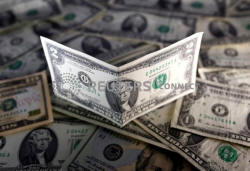Dollar set for biggest weekly rise since the 2008
financial crisis
 Send a link to a friend
Send a link to a friend
 [March 20, 2020] [March 20, 2020]
By Saikat Chatterjee
LONDON (Reuters) - The dollar eased on Friday as stock markets around
the world recovered but remained on track for its biggest weekly rise
since the global financial crisis in 2008 as a global scramble for
funding sent other currencies reeling.
Currencies from the Australian dollar <AUD=D3> to the British pound <GBP=D3>
tumbled to multi-year lows this week, after coordinated rate cuts by
central banks and billions of dollars of fund injections failed to calm
panicky markets.
But Friday restored some calm after days of selling. The Australian
dollar <AUD=D3> jumped 3.4%, although analysts warned that it was too
early to call an end to the rout.

The U.S. dollar is up about 3.5% against a basket of currencies <=USD>
through a week when investors have liquidated everything from stocks to
bonds to gold and commodities. It hit a three-year peak of 102.99 in
early Asian trading.
Gauges of expected market swings in the euro for one-month maturities
<EUR1MO=> edged lower while currency swap spreads, where most of the
funding pressure in dollar markets was evident in recent days, eased.
"The dollars are the grease in the cogs of the financial system and when
they were in short supply, things just weren't 'working'," said Brad
Bechtel, global head of FX at Jefferies LLC. "Now things are getting a
little better."
The euro was among the major gainers <EUR=EBS>, briefly up more than 1%
to $1.0832 before retracing some gains to stand 0.4% up on the day.
[to top of second column] |

U.S. dollar notes are seen in this November 7, 2016 picture
illustration. Picture taken November 7. REUTERS/Dado Ruvic

Sterling <GBP=D3> rose 3.3% from a 35-year low to $1.1878.
"People are selling everything and the common thread is they just want cash,"
said Stuart Oakley, a Singapore-based executive with Nomura, who runs the bank's
trading with its clients.
"People just want cash because at the end of the day, people don't know where
their next revenue is coming from and they've got payments to meet. I don't
think that's going to change."
Cross-currency basis swaps, which show the cost of borrowing dollars abroad,
showed that strains remained.
The premium over interbank rates that investors were paying to swap yen for
one-year dollar funding <JPYCBS1Y=> was around 68 basis points, close to the
2016 highs touched last week.
Euro cross-currency basis swap spreads also remain wide <EURCBS3M=ICAP>, but
tightened to 9 bps from levels of above 100 bps seen earlier this week.
Also showing a tightening trend is the FRA-OIS spread <USDF-O0X1=R>, a barometer
of risk in the interbank market.
(Reporting by Saikat Chatterjee Editing by Mark Heinrich)
[© 2020 Thomson Reuters. All rights
reserved.] Copyright 2020 Reuters. All rights reserved. This material may not be published,
broadcast, rewritten or redistributed.
Thompson Reuters is solely responsible for this content.
 |